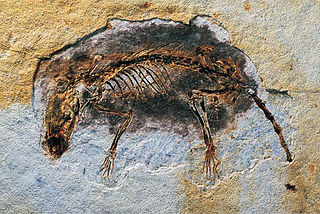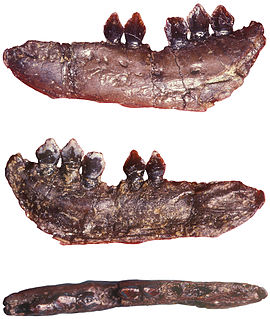
Placentalia is one of the three extant subdivisions of the class of animals Mammalia; the other two are Monotremata and Marsupialia. The placentals are partly distinguished from other mammals in that the fetus is carried in the uterus of its mother to a relatively late stage of development. The name is something of a misnomer considering that marsupials also nourish their fetuses via a placenta, though for a relatively briefer period, giving birth to less developed young who are then kept for a period in the mother's pouch.

Eomaia is a genus of extinct fossil mammals containing the single species Eomaia scansoria, discovered in rocks that were found in the Yixian Formation, Liaoning Province, China, and dated to the Barremian Age of the Lower Cretaceous about 125 million years ago. The single fossil specimen of this species is 10 centimetres (3.9 in) in length and virtually complete. An estimate of the body weight is between 20–25 grams (0.71–0.88 oz). It is exceptionally well-preserved for a 125-million-year-old specimen. Although the fossil's skull is squashed flat, its teeth, tiny foot bones, cartilages and even its fur are visible.

Eutheria is the clade consisting of all therian mammals that are more closely related to placentals than to marsupials.

Metatheria is a mammalian clade that includes all mammals more closely related to marsupials than to placentals. First proposed by Thomas Henry Huxley in 1880, it is a slightly more inclusive group than the marsupials; it contains all marsupials as well as many extinct non-marsupial relatives.
The Late Cretaceous is the younger of two epochs into which the Cretaceous geological period is divided in the geologic time scale. Rock strata from this epoch form the Upper Cretaceous series. The Cretaceous is named after the white limestone known as chalk, which occurs widely in northern France and is seen in the white cliffs of south-eastern England, and which dates from this time.

Echinodon is a genus of heterodontosaurid dinosaur that lived during the earliest Cretaceous of southern England in the Berriasian epoch. The first specimens were jaw bones named Echinodon becklesii by Sir Richard Owen in 1861, and since their original description only additional teeth have been discovered. The specific name honours collector Samuel Beckles who discovered the material of Echinodon and many other taxa from across England, while the genus name translates as "prickly tooth" in reference to the dental anatomy of the taxon.

Protungulatum is an extinct genus of mammal first found in the Bug Creek Anthills in northeastern Montana. The Bug Creek Anthills were initially believed to be Late Cretaceous because of the presence of the remains of non-avian dinosaurs and common Cretaceous mammals, but these were later shown to have been reworked from Late Cretaceous strata, and consequently the Bug Creek Anthills are currently believed to be Early Paleocene (Puercan) in age. Remains from the Ravenscrag Formation of Saskatchewan, Canada have been assigned to P. donnae. These remains may also be Cretaceous in age, but the age of the Ravenscrag Formation is not entirely certain. In 2011, remains of a new species of Protungulatum, P. coombsi, from the Hell Creek Formation, which is definitely Late Cretaceous (Maastrichtian) in age, proved that Protungulatum was present in both the Cretaceous and the Paleocene. It was initially assigned to the order condylarthra, a group of archaic "ungulates", that is now known to be polyphyletic. According to Archibald et al. (2011), Protungulatum is not even definitely a placental mammal. Some studies have found it to be close to Cetartiodactyla, but the most recent analysis holds it to be a non-placental eutherian.
Cimolestes is a genus of early eutherians with a full complement of teeth adapted for eating insects and other small animals. Paleontologists have disagreed on its relationship to other mammals, in part because quite different animals were assigned to the genus, making Cimolestes a grade taxon of animals with similar features rather than a genus of closely related ones. Fossils have been found in North America, South America, Europe and Africa. Cimolestes first appeared during the Late Cretaceous of North America. According to some paleontologists, Cimolestes died out at the start of the Paleocene, while others report the genus from the early Eocene.
Maelestes is a prehistoric shrew-like mammal discovered in 1997 in the Gobi Desert. The animal lived in the late Cretaceous Period, around 71-75 million years ago, and was a contemporary of dinosaurs such as Velociraptor and Oviraptor. According to some scientists, the discovery and analysis of this species suggests that true placental mammals appeared near the time the non-avian dinosaurs became extinct 66 million years ago, not much earlier in the Cretaceous as thought by others. However, the presence of an epipubic bone, among other characteristics, place it as a non-placental eutherian.

Vincelestes is an extinct genus of actively mobile mammal, that lived in what would be South America during the Early Cretaceous from 130—112 mya, existing for approximately 18 million years .

Leptictida is a possibly invalid extinct order of placental mammals. Their classification is contentious: according to cladistic studies, they may be (distantly) related to Euarchontoglires, although they are more recently regarded as the first branch to split from basal eutherians. One recent large-scale cladistic analysis of eutherian mammals favored lepictidans as close to the placental crown-clade; and several other recent analyses that included data from Cretaceous non-eutherian mammals found Leptictis to belong to the superorder Afrotheria.
Deltatheroides is an extinct genus of Deltatheridiidae from Cretaceous of Mongolia.
Pappotherium is an extinct genus of mammals from the Albian of Texas, US, known from a fossilized maxilla fragment bearing two tribosphenic molars, discovered within the Glen Rose Formation near Decatur, Wise County, Texas.
Oxlestes is an extinct mammal from the Late Cretaceous of Asia, more specifically from the Cenomanian of Uzbekistan. A carnivorous species of uncertain affinities, it is notable for its relatively large size, being among the largest of all Mesozoic mammals. Due to the limited amount of material, it has been considered a nomen dubium.
Zhelestidae is a lineage of extinct eutherian mammals. Occurring in the Late Cretaceous from the Turonian to the Maastrichtian, they were an extremely successful group, with representatives present in Europe, Asia, India, Africa and North America, ostensibly rendering them a cosmopolitan clade. They were specialised towards an herbivorous lifestyle and were in fact initially considered stem-ungulates, but the presence of epipubics and "archaic" dental characters render them as non-placental eutherians.
Valentinella is a Late Cretaceous genus of eutherian mammal from France, Europe. It was originally known from some damaged lower and upper jaws, and was cautiously referred to the lainodontine zhelestid mammals. This identification was later questioned and even considered a nomen dubium by some researchers, and remains uncertain due to the scarcity and fragmentary nature of the fossils.

Durlstodon is a genus of extinct mammal from the Early Cretaceous of Southern England. It contains a single species, Durlstodon ensomi, which is known from molars found in the Berriasian Lulworth Formation of Durlston Bay, Dorset, after which the genus was named. The species name honours Paul Ensom, discoverer of many fossil mammals from Lulworth. Durlstodon and two of its contemporaries, Tribactonodon and Durlstotherium, had tribosphenidan (three-cusped) molars, which are an advanced characteristic among eutherian mammals and suggest that the group emerged earlier than the Early Cretaceous.
Azilestes is a genus of probable zhelestid eutherian, a family consisting of small herbivores, that was discovered in the early Maastrichtian Grès de Labarre Formation of France. It is a monotypic genus, with only type species A. ragei being known. Only one specimen, the holotype described in 2021, is known. It consists of a partial dentary with teeth, and was discovered in sediments belonging to the Grès de Labarre Formation of France.

Gypsonictops is an extinct genus of leptictidan mammals of the monotypic family Gypsonictopidae, which was described in 1927 by George Gaylord Simpson. Species in this genus were small mammals and the first representatives of the order Leptictida, that appeared during the Upper Cretaceous.
Brasilestes is an extinct genus of mammals from the Late Cretaceous (Campanian-Maastrichtian) of South America. Its type species, B. stardusti, is named after David Bowie.
















